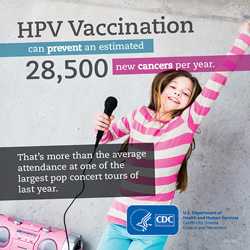Preventing HPV-Associated Cancers

HPV Vaccination can prevent an estimated 28,500 new cancers per year. That’s more than the average attendance at one of the largest pop concert tours of last year. View a larger version of this image in a new window.
Vaccines protect against the types of human papillomavirus (HPV) that most often cause cervical, vaginal, vulvar, and anal precancers and cancers, as well as the types of HPV that cause most genital warts. At this time, the HPV vaccine has not been shown to prevent precancers or cancers in other areas of the body, such as the penis or oropharynx, although the vaccine does protect against the HPV types that are most often found in those types of cancers.
Cervical cancer also can be prevented or found early through regular screening and follow-up treatment.
- The Pap test (or Pap smear) looks for precancers (cell changes on the cervix that might become cervical cancer if they are not treated appropriately). Women aged 21 to 65 years should get a Pap test every three years.
- The HPV test looks for the virus that can cause these cell changes. The HPV test may be used with the Pap test, if the Pap test findings aren’t clear. Women between the ages of 30 and 65 years who want to wait five years between screening tests may use both the Pap and HPV tests.
If your doctor finds any abnormal results from a cervical cancer screening test, make sure to follow up in case you need treatment or further tests.
Currently, screening tests for other types of HPV-associated cancers are not recommended.
More Information
- Page last reviewed: August 23, 2016
- Page last updated: August 23, 2016
- Content source:


 ShareCompartir
ShareCompartir